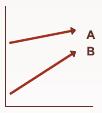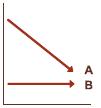- Surveys & Programs
- Data & Tools
- Fast Facts
- News & Events
- Publications & Products
- About Us
- Home
- Special Reports
- Achievement Gaps
- Understanding Gaps
Understanding Gaps
A difference in scores between two groups of students (for instance, male and female, Black and White, or Hispanic and White) can only be considered an achievement gap if the difference is statistically significant, meaning larger than the margin of error. There are several ways achievement gaps can change, as seen in the display below. Whether a gap narrows depends on the amount of change in the average scores for the two student groups. For example, a gap can narrow if the average scores of both groups improve, but one groups' scores improve more. If scores for both groups increase at the same rate, the score gap may not change.
NAEP data can be used to identify gaps and report on trends over time but cannot explain why gaps exist or why they change. The NAEP assessments are designed to measure student performance, not to identify or explain the causes of differences in student performance.
In each state, changes in the sizes of gaps could be affected by demographic or population changes, as well as policy changes in the school, district, and state. When reading the results, it is important to consider these factors.
Ways Gaps Can Narrow
 |
The average scores of both groups increase, while the score of the lower performing group increases even more. |
 |
The average score of the higher performing group does not change, while the score of the lower performing group increases. |
 |
The average score of the higher performing group declines, while the score of the lower performing group increases. |
 |
The average score of the higher performing group declines, while the score of the lower performing group does not change. |
 |
The average scores of both groups decline, but the score of the higher performing group declines even more. |
 |
The average scores of both groups do not change significantly, but the combined effect causes a narrowing of the gap that is significant. |
Last updated 17 June 2011 (EP)